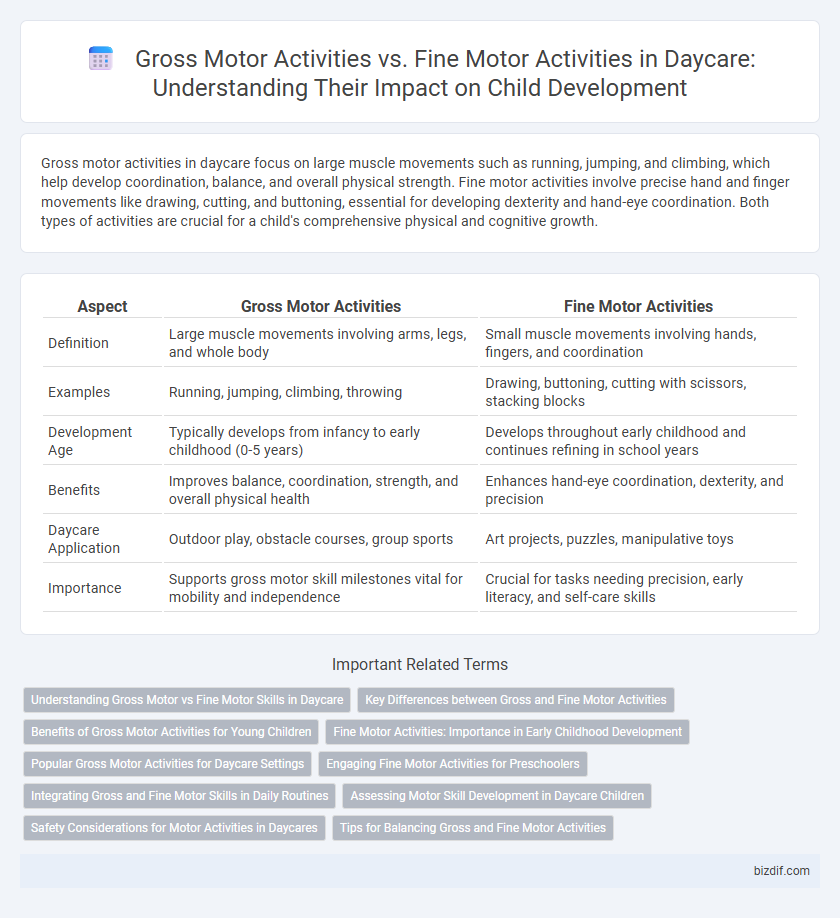Gross motor activities in daycare focus on large muscle movements such as running, jumping, and climbing, which help develop coordination, balance, and overall physical strength. Fine motor activities involve precise hand and finger movements like drawing, cutting, and buttoning, essential for developing dexterity and hand-eye coordination. Both types of activities are crucial for a child's comprehensive physical and cognitive growth.
Table of Comparison
| Aspect | Gross Motor Activities | Fine Motor Activities |
|---|---|---|
| Definition | Large muscle movements involving arms, legs, and whole body | Small muscle movements involving hands, fingers, and coordination |
| Examples | Running, jumping, climbing, throwing | Drawing, buttoning, cutting with scissors, stacking blocks |
| Development Age | Typically develops from infancy to early childhood (0-5 years) | Develops throughout early childhood and continues refining in school years |
| Benefits | Improves balance, coordination, strength, and overall physical health | Enhances hand-eye coordination, dexterity, and precision |
| Daycare Application | Outdoor play, obstacle courses, group sports | Art projects, puzzles, manipulative toys |
| Importance | Supports gross motor skill milestones vital for mobility and independence | Crucial for tasks needing precision, early literacy, and self-care skills |
Understanding Gross Motor vs Fine Motor Skills in Daycare
Gross motor activities in daycare involve large muscle movements such as running, jumping, and climbing that enhance coordination, balance, and overall physical strength in young children. Fine motor activities focus on small muscle tasks like drawing, buttoning, and manipulating small objects, critical for developing hand-eye coordination and precise dexterity. Understanding the distinction between these skill sets helps educators design balanced programs that promote comprehensive physical and cognitive development in early childhood.
Key Differences between Gross and Fine Motor Activities
Gross motor activities involve large muscle groups and include movements like running, jumping, and climbing, which are essential for overall physical development and coordination in daycare children. Fine motor activities focus on smaller muscles, particularly in the hands and fingers, such as drawing, cutting with scissors, and buttoning clothes, enhancing dexterity and hand-eye coordination. Understanding the key differences between gross and fine motor activities enables caregivers to create balanced daycare programs that support comprehensive motor skill development.
Benefits of Gross Motor Activities for Young Children
Gross motor activities in daycare settings significantly enhance young children's physical development by improving balance, coordination, and muscle strength. These activities support overall health and promote cognitive growth by encouraging exploration and problem-solving through active play. Engaging in gross motor exercises also fosters social skills as children interact with peers during group activities.
Fine Motor Activities: Importance in Early Childhood Development
Fine motor activities, such as drawing, cutting with scissors, and manipulating small objects, play a crucial role in early childhood development by enhancing hand-eye coordination and dexterity. These activities support cognitive growth by improving concentration, problem-solving skills, and the ability to complete tasks independently. Developing fine motor skills lays the foundation for essential academic abilities like writing and typing, making them vital for lifelong learning and success.
Popular Gross Motor Activities for Daycare Settings
Popular gross motor activities in daycare settings include climbing structures, balance beams, hopping, and running games that promote large muscle development and coordination. These activities not only enhance children's physical strength and endurance but also improve spatial awareness and social interaction skills. Incorporating equipment like tunnels, jump ropes, and tricycles fosters active play essential for healthy growth in early childhood.
Engaging Fine Motor Activities for Preschoolers
Engaging fine motor activities for preschoolers, such as threading beads, using child-safe scissors, and manipulating playdough, significantly enhance hand-eye coordination and dexterity essential for writing skills. These activities support the development of small muscle groups in the fingers and hands, improving precision and control. Incorporating puzzles, drawing, and buttoning exercises within a daycare setting fosters cognitive growth alongside fine motor proficiency.
Integrating Gross and Fine Motor Skills in Daily Routines
Incorporating both gross motor activities such as jumping, running, and climbing alongside fine motor tasks like drawing, buttoning, and manipulating small objects enhances overall child development in daycare settings. Structured playtime that blends these skills encourages coordination, balance, and hand-eye precision, fostering cognitive and physical growth simultaneously. Daily routines that integrate climbing structures with craft sessions or obstacle courses with puzzles create a dynamic environment promoting comprehensive motor skill advancement.
Assessing Motor Skill Development in Daycare Children
Assessing motor skill development in daycare children involves differentiating between gross motor activities, such as running, jumping, and climbing, and fine motor activities, including drawing, buttoning, and manipulating small objects. Gross motor skills enhance balance, coordination, and muscle strength, while fine motor skills support hand-eye coordination and precision. Careful observation and age-appropriate tasks enable caregivers to track progress and identify developmental milestones or delays in both motor domains.
Safety Considerations for Motor Activities in Daycares
Safety considerations for gross motor activities in daycares prioritize ample space, secure flooring, and age-appropriate equipment to prevent falls and collisions. Fine motor activities require non-toxic, size-appropriate materials to avoid choking hazards and promote safe handling skills. Careful supervision and regular equipment inspection are essential to maintaining a safe environment for all motor skill development.
Tips for Balancing Gross and Fine Motor Activities
Balancing gross motor activities, such as running and jumping, with fine motor activities like drawing and buttoning is essential for comprehensive child development in daycare settings. Incorporate varied playtime that alternates between large muscle group exercises and precise hand movements to enhance coordination and strength. Scheduling diverse activity stations ensures children develop both physical endurance and fine motor skills critical for daily tasks and academic readiness.
Gross motor activities vs Fine motor activities Infographic

 bizdif.com
bizdif.com